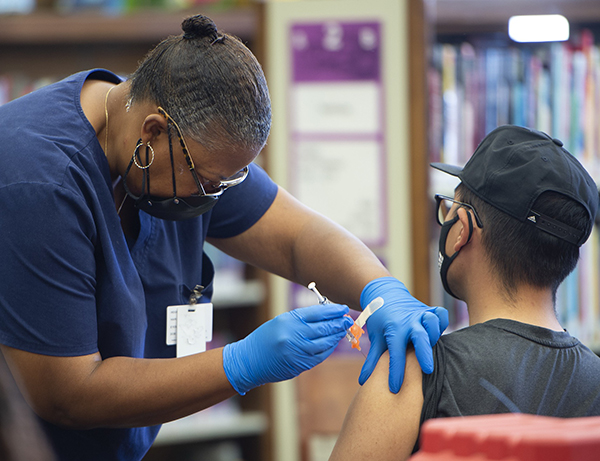By Typhanye Vielka Dyer
Guest Columnist
Earlier this year, I reported on the statistics of vaccine effectiveness from the Centers for Disease Control (CDC) and World Health Organization (WHO).
Now that some of you have decided to get vaccinated, I wanted to write a follow-up piece on how the tides have turned and address the racial and ethnic inequities that continue to exist when it comes to vaccinating people of color.
If you recall, at the onset of the pandemic, the CDC and WHO were aggressively promoting messages about the strong need for Black and Hispanic Americans to get vaccinated since they resided in “communities of concern.”
Well fast forward to today with 378.8 million Americans being fully vaccinated. That roughly equates to 117 doses per 100 people, or 117% of Americans. In addition, 77% of the total U.S. population has also received at least one dose of a two-dose vaccine regimen. Awesome, right? Well not so much.
When you zoom in on those statistics and revisit those Black and brown Americans in their “communities of concern,” what you will see is that of the total percentage of Americans who have received at least one dose are only 10% Black and 17% Hispanic. Not to mention that Black people have received smaller shares of the vaccines compared to their percentage of positive cases and COVID-related deaths.
Case in point. To date, roughly 23,633,862 Americans have been fully vaccinated, with Black people making up only 4.2% of the total. 4.2%? How is that if African Americans account for 13% of the U.S. population? If my math is correct, shouldn’t we have a higher percentage of Black people who have been fully vaccinated?
And we’re not alone. You can also find vaccine disparities in the Hispanic community, as well. For example, take California where Hispanics make up 40% of the state’s total population. When it comes to being fully vaccinated, Hispanics make up only 31%; but account for 61% of positive COVID cases and 47% of COVID-related deaths. Disparities indeed.
With statistics like these, not only does it serve as a constant reminder of this country’s hypocrisy on their equitable distribution efforts in “communities of concern,” but it also gives rise and credibility as to why so many Black people continue to distrust our medical and scientific communities at a time we really shouldn’t be.
And when it comes to the Delta Variant, this strain has been relentless and continues to cause spikes in positive COVID cases, deaths and breakthrough infections among the fully vaccinated. So we really have to do our best to protect ourselves from contracting it.
What am I saying? In short, while I truly understand why medical distrust continues to pervade the psyche and behaviors of Black people, I challenge us to also recognize the apparent racial/ethnic disparities of vaccine distribution within this country and question why they exist.
If getting people of color vaccinated was such a national health priority, why are we now among the least vaccinated, but the most impacted? What’s really going on here? Like Einstein said, “Question everything,” right?
So while we ponder the question of vaccine inequalities in our communities, let’s continue being advocates for our health and the health of our families and communities. And if you’re still contemplating whether or not you should get vaccinated, I understand.
But as one who teaches about infectious diseases, I wouldn’t be doing my job if I didn’t at least encourage you to continue wearing your mask, washing your hands frequently and practicing social distancing.
For the fully vaccinated? I encourage you to consider getting the booster if you have the Pfizer vaccine and are within the categories of eligible recipients — people over 65 years of age, those who reside in a nursing home, or people 50 to 64 who have an underlying health problem. It’s better to be safe than sorry. Breakthrough cases do exist.
Oh and one last point. COVID isn’t going anywhere, anytime soon. It just isn’t. Infectious disease experts are doing their very best to track its behavior and keep watch on any other variants. It’s their job.
So, while they’re doing their job, let’s continue to focus on ours — doing any and everything we need to do to protect the most vulnerable in the community, our youth and our elderly. We owe ourselves to make sure that we strive to preserve our past, while also saving our future.
Typhanye Vielka Dyer is a tenured associate professor of epidemiology at the University of Maryland School of Public Health in College Park, Maryland. A Los Angeles native, she attended UCLA as an undergraduate and doctoral student.













